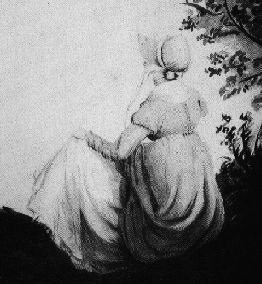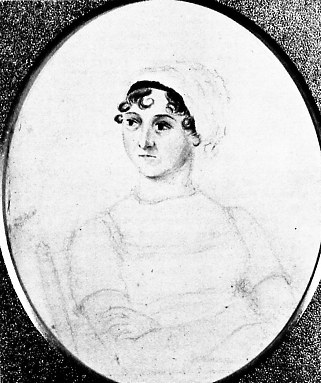Jane Austen and Time: A Study of her Uses of the Almanac
All calendars, chronologies, and essays about Jane Austen and her novels are copyright © Ellen Moody 1998, 1999, 2000, 2001, 2002, 2003

Jane Austen
Watercolour by Cassandra (detail). When placed against Carl Gustav Carus's 1824 Woman on a Balcony, or the illustration to an Italian version of Mysteries of Udolpho, Cassandra's picture turns into a depiction of absorption (and not a perverse refusal to show Jane's face)
All those who have studied Austen texts carefully soon realise that she develops her stories through a careful sequencing of time. Scenes, pictorial narratives, meditations are all placed in a rhythm which imitates diurnal time as all people communally experience it. This sequencing is the framework within which she will suddenly slow down a narrative and devote chapters to a single experience which psychological or individual time remembers as having occurred over a long while. To achieve the on-going rhythm of two kinds of verisimilitude she used the almanacs of her day as the structuring underpinnings of her books. There have been numerous articles by Austen scholars arguing that a particular novel is set in a particular year and what we may infer from this. What I have done is read all these and through a close reading of Austen's works drawn a probable calendar out for each.
The visitor to my site is invited to look at each of the calendars in order to discover the ways in which each novel is put together. When you discover this, you can see the different goals Austen had for each novel, and geologize into the early history of the revisions, and the ways in which she uses omniscient, epistolary, and psychological narrative. Or the reader can use these calendars to understand the novel that is in front of them more clearly simply to enrichen reading of the novel, to see what is literally there and the fineness of Austen's art. The calendars are also intended to help people writing about and teaching Austen who want to reach her text in the most fundamental way.
In each of the sections I have included a bibliography for further research for each novel. For general information on almanacs in the period, the reader is referred to Bernard Capp's English Almanacs, 1500-1800: Astrology and the Popular Press (Ithaca: Cornell University Press, 1979), For persuasive arguments that Austen was more or less continually at work on her novels from the initial writing of the first drafts beginning in 1793-94 of Susan (later Northanger Abbey); Elinor and Marianne (later Sense and Sensibility); and First Impressions (later Pride and Prejudice; to the rough first draft gotten down in 1817 of the fragment of a novel Chapman entitled Sanditon (perhaps called by Austen The Brothers); see Q. D. Leavis, "A Critical Theory of Jane Austen's Writings", Scrutiny, 10 (1941-42), pp. 114-142, 272-294; 12 (1944-45), pp. 104-119, Brian Southam's Jane Austen's Literary Manuscripts: A Study of the Novelist's development through the surviving papers (Oxford: Clarendon Press, 1964) and Yasmine Gooneratne's Jane Austen (Cambridge: At the University Press, 1970).
My work on Anne Finch came into this project too: in Heneage Finch's later years (after Anne died), he kept his diary on the back pages of an almanac; he also recorded one of her poems which does not appear in any edition printed yet on the back page of one of these sheets. Having studied his almanac very thoroughly, I had a good understanding of what such books were which Austen kept beside her as she wrote. They include such things as interest in astrology which makes the place of the moon, planets and stars significant. Austen will use the position of the sun in the sky at a given time, on a given day in a specific year as part of her setting.
I present the calendars in the order in which I think the texts were written. I have not yet drawn the calendar from the very early epistolary fragment "Lesley Castle" (from Volume the second) but list the fragment and hope to include an abstract of the calendar eventually.
Using these calendars and my study of all the primary documents and much secondary literature on Austen of all kinds, I have written a chronology of Austen's writing life.
These calendars also reveal a startling pattern built into the novels by Austen . Excepting only Northanger Abbey, Austen makes sure a certain kind of pivotal event in her longer finished novels occurs on a Tuesday. This pivotal event is a snubbing or humiliation of the heroine or hero (or anti-hero or co-heroine), some sort of mortification or unpleasant awakening which climaxes, or provides important turning points in Austen's narrative. This "bad Tuesday" occurs as early as the Juvenilia (in "A Collection of Letters" in the fourth letter the unhappy Miss Grenville arrived in Essex on Tuesday). For most of these dramatic moments one does not even have to work out that the day is Tuesday. Austen will cite the day as Tuesday at least once, in some cases a couple of times -- apparently determined to make Tuesday a significant day.
I have also placed on this site for Jane Austen:
Jane Austen and Bath:
Reviews of:

Jane Austen by Cassandra Austen
Page Last Updated: 3 January 2003

